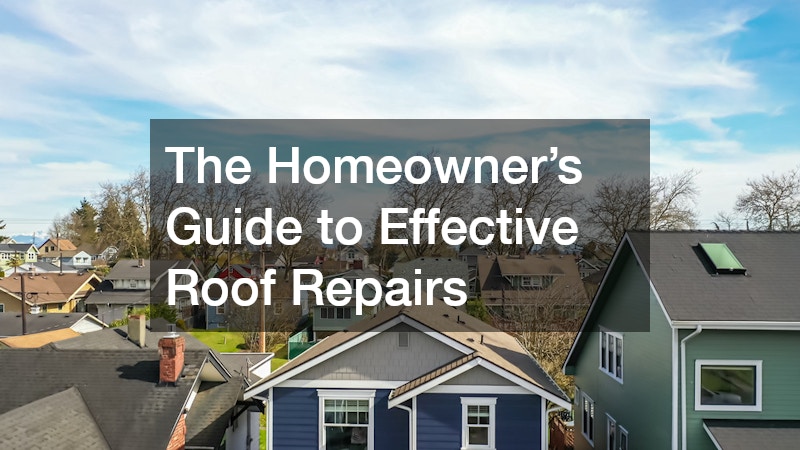
The Homeowner’s Guide to Effective Roof Repairs
The roof is one of the most critical components of a house, protecting homeowners and their property from the elements. Neglecting roof repairs can lead to severe damage, escalating into more significant and costly problems over time. This guide aims to equip homeowners with essential knowledge to maintain their roofs effectively, ensuring safety and longevity.
Identifying Shingle Damage
Shingle damage is often one of the most visible indicators of roof problems. Common causes include severe weather conditions, poor installation, and aging materials, all of which compromise a roof’s integrity. Regular inspections can help spot missing, curling, or cracked shingles, preventing further deterioration.
Assessing shingle damage involves checking for indications such as granule loss, which often accumulates in gutters after a storm. Such damage not only affects the house’s appearance but can also lead to leaks and structural issues if left unaddressed. Timely intervention is crucial to replace or repair damaged shingles, thereby preserving the roof’s protective layer.
Recognizing Water Leaks
Water leaks signify potential roof damage and can culminate in extensive problems if not promptly addressed. Visible signs of water damage include wet spots on ceilings, damp walls, and unexplained puddles in the attic. Identifying their source is vital for implementing effective repairs, as leaks can originate from broken shingles, flashing issues, or clogged gutters.
Preventative measures such as regular cleaning of gutters and ensuring proper attic ventilation are essential to mitigate water leak risks. By doing so, homeowners can prevent water accumulation, which exacerbates leaks and damages the roof’s underlying structure. Keeping track of these issues early can save homeowners from hefty repair costs.
Understanding Structural Issues
Structural issues often manifest as more severe problems such as sagging roofs or evident weak points within the framework. Causes can range from poor construction practices to the natural settling of materials over time, impacting the roof’s overall performance. Regular roof evaluations can help detect signs of structural deterioration that require immediate attention.
Weak points, often found where different roof sections meet, pose risks to both roof integrity and safety. These issues may lead to water pooling and additional stress on the roof structure, necessitating timely interventions. Using reinforcing materials and correcting underlying problems can avert potential hazards.
Evaluating Roof Age
The lifespan of a roof greatly depends on the materials used, with asphalt shingles typically lasting 20 years, while metal roofs can serve for over five decades. As a roof ages, natural wear and environmental factors increase the likelihood of damage. Evaluating the roof’s age will guide homeowners in deciding whether repair or replacement is the optimal choice.
Indicators that age is affecting a roof include frequent damages, increased frequency of repairs, and energy inefficiencies. Older roofs are more prone to leakages, cracked materials, and insulation issues, all of which necessitate frequent monitoring. Understanding the specific lifespan of a roof type allows homeowners to plan and budget for future replacement projects.
Cost-Benefit Analysis of Repairs vs. Replacement
Financial considerations play a pivotal role in a homeowner’s decision to repair or replace their roof. Repairs may seem less costly initially, but frequent fixes on an old roof may add up compared to investing in a new one. A comprehensive cost-benefit analysis considers immediate repair expenses against the long-term investment of a new roof.
Homeowners should evaluate variables such as energy savings, warranties, and potential for future maintenance when deciding between repair and replacement. Replacement may offer greater efficiency and improved property value, justifying the upfront costs. Calculating savings from reduced repair frequency and increased home values supports informed decision-making.
Assessing the Extent of Damage
The extent of roof damage deeply influences whether repair or replacement is more practical. Extensive damage, such as widespread leaks or structural weakening, often warrants complete replacement. Conversely, localized issues or minor leaks may only require targeted repairs to restore full functionality.
Professional assessment is crucial in accurately determining the severity of damage and appropriate action. Evaluations should include roof inspections to identify problematic areas, structural tests, and moisture penetration assessments. A detailed understanding of the damage ensures that repair work addresses all contributing factors, preventing further issues.
Comparing Roofing Materials
Different roofing materials offer varied benefits and challenges, influencing both durability and costs. Materials like asphalt shingles, metal, or clay tiles differ in lifespan, aesthetic appeal, and maintenance needs. Comparing these options allows homeowners to choose a material that aligns with budgetary and environmental preferences.
Factors like local climate and architectural style should also guide selection, as some materials perform better under specific weather conditions. Choosing the correct material can enhance energy efficiency, reduce maintenance costs, and provide long-term reliability. Informed choices based on these parameters pave the way for effective roof maintenance.
Environmental Considerations
The growing focus on sustainability necessitates choosing eco-friendly roofing materials for roof repairs and replacements. Materials like recycled shingles or metal roofs, which can be repurposed at the end of their life, contribute to a reduced environmental footprint. Opting for these materials aligns personal home improvement goals with wider environmental responsibilities.
The significance of timely roof repairs cannot be overstated, as an efficient, well-maintained roof is integral to home safety and value. Making informed choices about repair versus replacement, material selection, and embracing modern technologies ensures a robust roofing strategy. Such decisions not only enhance home protection but also align with sustainable living goals for a healthier environment.
